Pathological Findings in Cattle Slaughtered in Northeastern Algeria and Associated Risk Factors
Abstract
Simple Summary
Abstract
1. Introduction
2. Materials and Methods
2.1. Study Area
2.2. Animals and Study Method
2.2.1. Animals
2.2.2. Ante-Mortem Examination
2.2.3. Post-Mortem Examination
2.2.4. Risk Factors
2.3. Statistical Analysis
3. Results
3.1. Overall Results
3.2. Distribution of Lesions According to the Organs Affected
3.3. Distribution of Lesions According to the Sex
3.4. Distribution of Lesions by Age Group
3.5. Distribution of Lesions by Breed
4. Discussion
5. Conclusions
Author Contributions
Funding
Institutional Review Board Statement
Informed Consent Statement
Data Availability Statement
Acknowledgments
Conflicts of Interest
References
- Godfray, H.; Charles, J.; Aveyard, P.; Garnett, T.; Hall, J.W.; Key, T.J.; Lorimer, J.; Pierrehumbert, R.T.; Scarborough, P.; Springmann, M.; et al. Meat consumption, health, and the environment. Science 2018, 361, 243. [Google Scholar] [CrossRef] [PubMed]
- APS. Viandes Rouges: Une Production Nationale de Plus de 5 Millions de Quintaux en 2017. Algérie Presse Service, 2017. Available online: https://www.aps.dz/economie/75838-viandes-rouges-une-production-nationale-de-plus-de-5-millions-de-quintaux-en-2017 (accessed on 15 October 2021).
- APS. Gel des Importations des Viandes Rouges: 200 Millions USD à Préserver Annuellement. Algérie Presse Service, 2021. Available online: https://www.aps.dz/economie/116361-importation-des-viandes-rouges-plus-de-200-millions-de-dollars-a-preserver-annuellement (accessed on 13 October 2021).
- Williams, P.; Brent, P. Essentials of Human Nutrition; Mann, J., Truswell, A.S., Eds.; Oxford University Press: Oxford, UK, 2017; pp. 316–336. ISBN 9780198752981. [Google Scholar]
- Mimoune, N.; Seddiki, S.; Baazizi, R.; Saboundji, I.E.; Saidi, R.; Khelef, D.; Kaidi, R. Antibiotic residues in cow’s milk. Vet. Stanica 2021, 52, 499–509. [Google Scholar] [CrossRef]
- Mimoune, N.; Saidi, R.; Benadjel, O.; Khelef, D.; Kaidi, R. Alternative treatment of bovine mastitis. Vet. Stanica 2021, 52, 639–649. [Google Scholar] [CrossRef]
- Lamari, I.; Mimoune, N.; Khelef, D. Effect of feed additive supplementation on bovine subclinical mastitis. Vet. Stanica 2021, 52, 445–460. [Google Scholar] [CrossRef]
- de Jijel, W. Rubrique Monographie Wilaya; ANIREF: Alger, Algérie, 2011; p. 5. Available online: https://docplayer.fr/179620592-Rubrique-monographie-wilaya.html (accessed on 15 October 2021).
- Rodier, J.; Legube, B.; Merlet, N.; Brunet, R. L’analyse de l’eau. Eau naturelles, Eaux Résiduaires, eau de mer. In Caractérisation des Eaux D’irrigation Destinées à L’agriculture Dans le Périmètre de Jijel-Taher; Nafa, S., Hamrouche, A., Eds.; Mémoire de fin d’étude (Master); Département du génie des procédés, Université de Jijel: Jijel, Algeria, 2009; p. 70. Available online: http://dspace.univ-jijel.dz:8080/xmlui/bitstream/handle/123456789/308/M-GP.ENV-2019-09.pdf?sequence=1&isAllowed=y (accessed on 14 October 2021).
- Titi, A.; Mekroud, A.; Chibat, M.E.H.; Boucheikhchoukh, M.; Zein-Eddine, R.; Djuikwo-Teukeng, F.F.; Vignoles, P.; Rondelaud, D.; Dreyfuss, G. Ruminal paramphistomosis in cattle from northeastern Algeria: Prevalence, parasite burdens and species identification. Parasite 2014, 21, 50. [Google Scholar] [CrossRef][Green Version]
- Ibrahem, M.M.; Ibrahem, W.M.; Abdorrahem, M.M.; Ibrahem, K.M. Livestock Hydatid Disease (Cystic Hydatidosis) in Libya: A Review. Am. J. Anim. Vet. Sci. 2016, 11, 70–84. [Google Scholar] [CrossRef][Green Version]
- Stoore, C.; Andrade, C.; Hidalgo, C.; Corrêa, F.; Jiménez, M.; Hernandez, M.; Paredes, R. Echinococcus granulosus hydatid cyst location is modified by Fasciola hepatica infection in cattle. Parasites Vectors 2018, 11, 542. [Google Scholar] [CrossRef]
- Kayoueche, F.Z. Epidemiology of Hydatidosis and Fascioliasis in Animals and Humans in Eastern Algeria. Ph.D. Thesis, Department of Veterinary Sciences, Faculty of Natural and Life Sciences, Mentouri University, Constantine, Algeria, 2009. [Google Scholar]
- Belkhiri, M.; Tlidjane, M.; Meziane, T. Fréquence des lésions pulmonaires des bovins et ovins de Tiaret et Batna (Algérie). Frequency of sheep and cattle lung lesions in Tiaret and Batna (Algeria). Département vétérinaire—faculté des sciences—université de Batna—Algérie. Renc. Rech. Rumin. 2008, 15, 86. Available online: http://www.journees3r.fr/IMG/pdf/2008_03_sante_04_Belkhiri.pdf (accessed on 15 October 2021).
- Elshraway, N.T.; Mahmoud, W.G. Prevalence of fascioliasis (liver flukes) infection in cattle and buffaloes slaughtered at the municipal abattoir of El-Kharga, Egypt. Vet. World 2017, 10, 914–917. [Google Scholar] [CrossRef]
- Meguini, M.N.; Righi, S.; Bouchekhchoukh, M.; Sedraoui, S.; Benakhla, A. Investigation of flukes (Fasciola hepatica and Paramphistomum sp.) parasites of cattle in north-eastern Algeria. Ann. Parasitol. 2021, 67, 455–464. [Google Scholar] [CrossRef]
- Nyirenda, S.S.; Sakala, M.; Moonde, L.; Kayesa, E.; Fandamu, P.; Banda, F.; Sinkala, Y. Prevalence of bovine fascioliasis and economic impact associated with liver condemnation in abattoirs in Mongu district of Zambia. BMC Vet. Res. 2019, 15, 33. [Google Scholar] [CrossRef] [PubMed]
- Mekroud, A.; Benakhla, A.; Vignoles, P.; Rondelaud, D.; Dreyfuss, G. Preliminary studies on the prevalences of natural fasciolosis in cattle, sheep, and the host snail (Galba truncatula) in north-eastern Algeria. Parasitol. Res. 2004, 92, 502–505. [Google Scholar] [CrossRef] [PubMed]
- Bendiaf, H. Contribution à L’étude de la Distomatose à Fasciola hepatica (Linné, 1758): Aspects Parasitologique et Sérologique. Master’s Thesis, Université Mentouri Constantine, Département des Sciences Vétérinaires, Constantine, Algeria, 2011; p. 177. Available online: http://archives.umc.edu.dz/bitstream/handle/123456789/12438/BEN5981.pdf?sequence=1&isAllowed=y (accessed on 15 October 2021).
- Bentounsi, B.; Mecif, A.; Kohil, K. Evolution du parasitisme ovin sur un élevage de la région du Khroub. Approche par les méthodes coproscopiques. Sci. Technol. 2001, 16, 51–54. Available online: https://www.asjp.cerist.dz/en/downArticle/15/0/16/63803 (accessed on 15 October 2021).
- Hamiroune, M.; Dahmane, M.; Charef, A.; Cheniguel, H.; Foughalia, H.; Saidani, K.; Djemal, M. Evaluation of Fascioliasis, Hydatidosis, and Tuberculosis in Domestic Animals during Post-Mortem Inspection at Jijel Slaughterhouse (Algeria). J. Food Qual. Hazards Control 2020, 7, 149–156. [Google Scholar] [CrossRef]
- Doutoum, A.A.; Hamid, A.A.; Doungous, D.M.; Sakhaïroun, A.; Tidjani, A.; Markhous, A.N.; Moukhtar, R.; Seydi, M.; Abdourahamane, B. Motifs de saisies de viandes rencontrées à l’abattoir frigorifique de Farcha (N’Djamena/Tchad). Rev. Sci. Du Tchad Série B-Janvier 2020, 17–35. Available online: https://cnar-cnrd.org/images/revue/serieB/RST-Serie_B-janvier_2020.pdf (accessed on 15 October 2021).
- Blaise, F. Prévalence et fréquence des lésions parasitaires du foie et du poumon des ruminants en Haïti. Rev. Méd. Vét. 2001, 152, 269–274. Available online: https://agris.fao.org/agris-search/search.do?recordID=FR2001002435 (accessed on 15 October 2021).
- Figuerora, J.P.; Maier, N.L. Veme Congreso de Especialistas en pequenos ruminantes y camelidos Sudamericanos, Mendoza, Argentina. 2007. Available online: https://www.uchile.cl/agenda/121542/x-congreso-latinoamericano-en-pequenos-rumiantes-y-camelidos (accessed on 15 October 2021).
- Malone, F.E.; Fee, S.A. A serological investigation of caseous lymphadenitis in four flocks of sheep. Irish Vet. J. 2006, 59, 19–21. Available online: https://pubmed.ncbi.nlm.nih.gov/21851675/ (accessed on 14 October 2021). [CrossRef]
- Alloui, M.N.; Ayachi, A.; Alloui, N.; Tlidjane, M.; Kaba, J. Prévalence de la maladie des abcès des petits ruminants dans la región de Batna (Algérie). Renc. Rech. Rumin. 2008, 15, 87. Available online: http://www.journees3r.fr/IMG/pdf/2008_03_sante_05_Alloui.pdf (accessed on 14 October 2021).
- Benet, J.J.; Praud, A. La Tuberculose Animale; Polycopié des Unités de maladies contagieuses des Ecoles Nationales Vétérinaires françaises, Mérial: Lyon, France, 2014; p. 100. [Google Scholar]
- Nielsen, S.S.; Denwood, M.J.; Forkman, B.; Houe, H. Selection of Meat Inspection Data for an Animal Welfare Index in Cattle and Pigs in Denmark. Animals 2017, 7, 94. [Google Scholar] [CrossRef]
- Nour mohammadzadeh, F.; Haji Hajikolaei, M.R.; Sasani, F.; Alidadi, N. Abattoir study of the prevalence of renal lesions in slaughtered cattle. Int. J. Vet. Res. 2010, 4, 173–175. Available online: https://www.sid.ir/en/journal/ViewPaper.aspx?id=185143 (accessed on 15 October 2021).
- Mahouz, F.; Khoudja, F.B.; Chikhaoui, M. Pathological study on renal Diseases in Cattle and Sheep. J. Anim. Vet. Adv. 2015, 14, 357–360. [Google Scholar] [CrossRef]
- Kilani, M.; Chermette, R.; Guillot, J.; Polack, B.; Duncan, J.L.; Cabaret, J. Gastrointestinal helminthoses: Amphistomosis. In Infectious and Parasitic Diseases of Livestock; Lefèvre, P.C., Blancou, J., Chermette, R., Uilenberg, G., Eds.; Lavoisier: Paris, France, 2010; pp. 1589–1601. [Google Scholar]
- Mimoune, N.; Kaidi, R.; Azzouz, M.Y.; Keddour, R.; Belarbi, A.; Derdour, S.Y. Genital Tract Pathologies of Cows Slaughtered at El-Harrach Abattoir in Algeria. Kafkas Univ. Vet. Fak. Derg. 2016, 22, 639–646. [Google Scholar] [CrossRef]
- Mimoune, N.; Khelef, D.; Kaidi, R. Ovarian cysts in cattle: A survey among veterinary practitioners in Algeria. Vet. Stanica 2021, 52, 587–603. [Google Scholar] [CrossRef]
- Escobar, L.E.; Romero-Alvarez, D.; Leon, R.; Lepe-Lopez, M.A.; Craft, M.E.; Borbor-Cordova, M.J.; Svenning, J.-C. Declining Prevalence of Disease Vectors under Climate Change. Sci. Rep. 2016, 6, 39150. [Google Scholar] [CrossRef] [PubMed]
- Doyle, J.J. Evidence of an acquired resistance in calves to a single experimental Infection with Fasciola hepatica. Res. Vet. Sci. 1972, 13, 456–459. [Google Scholar] [CrossRef]
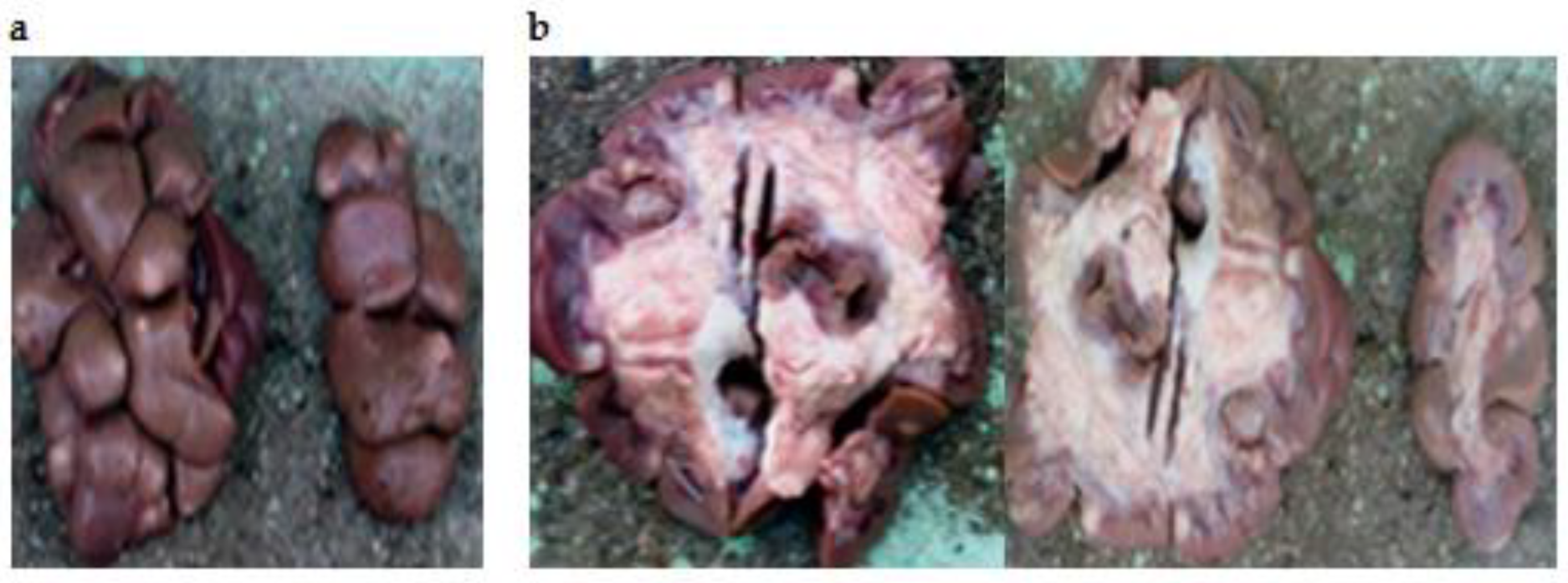
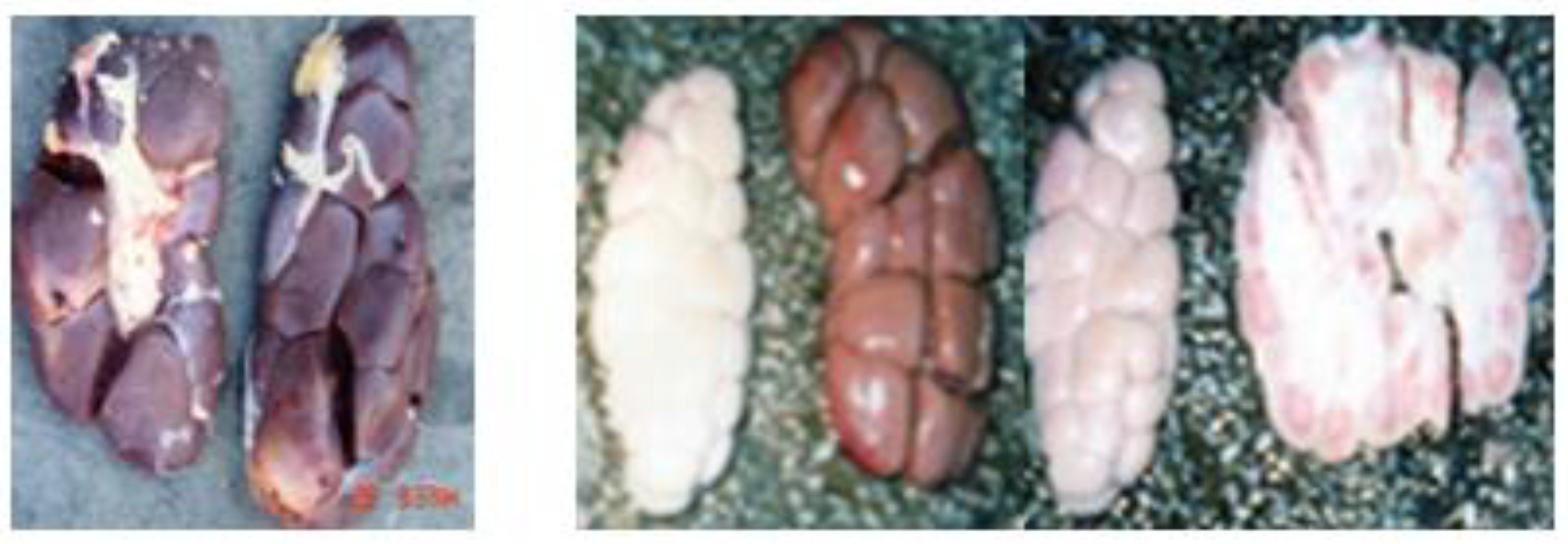
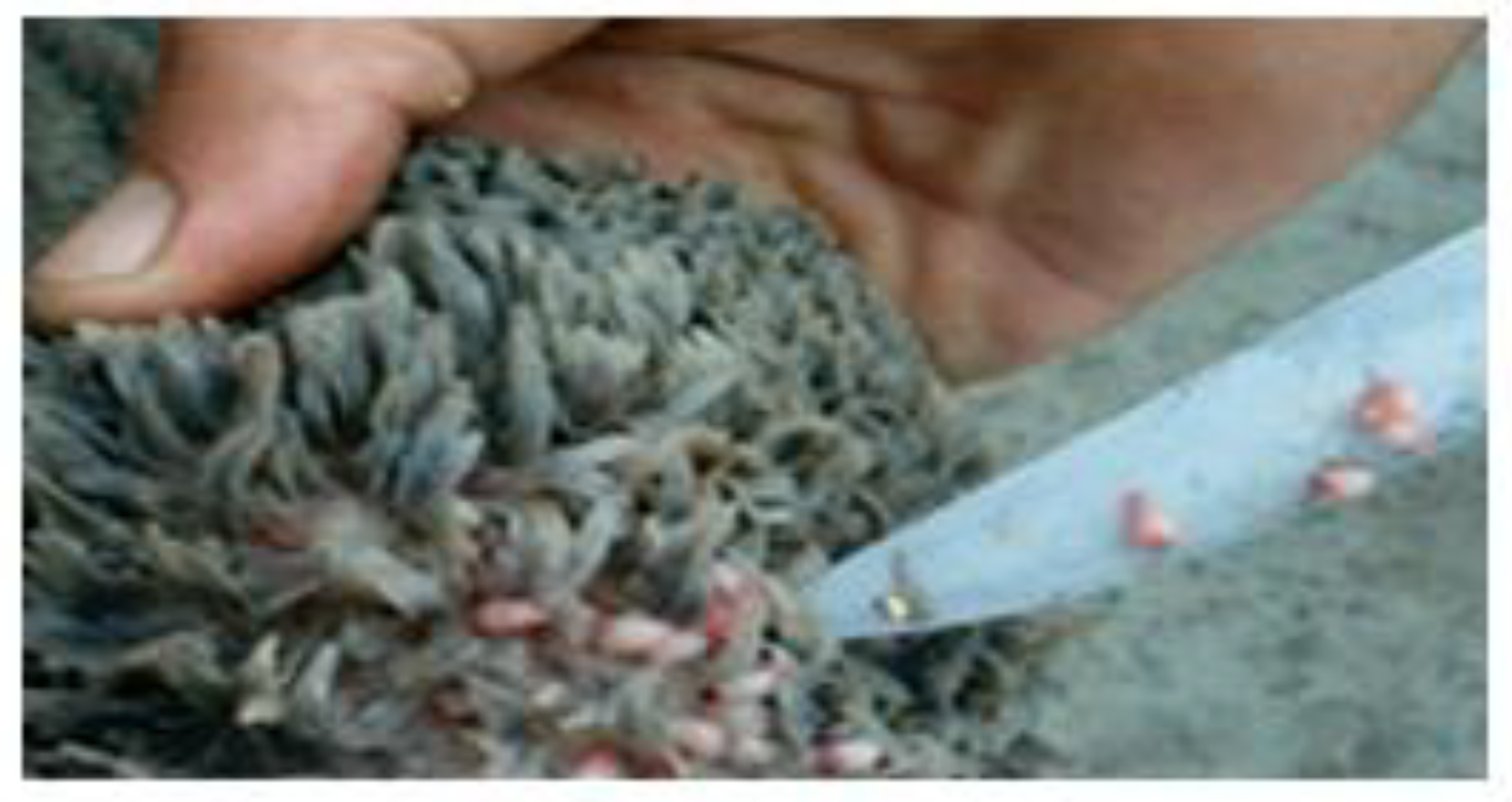
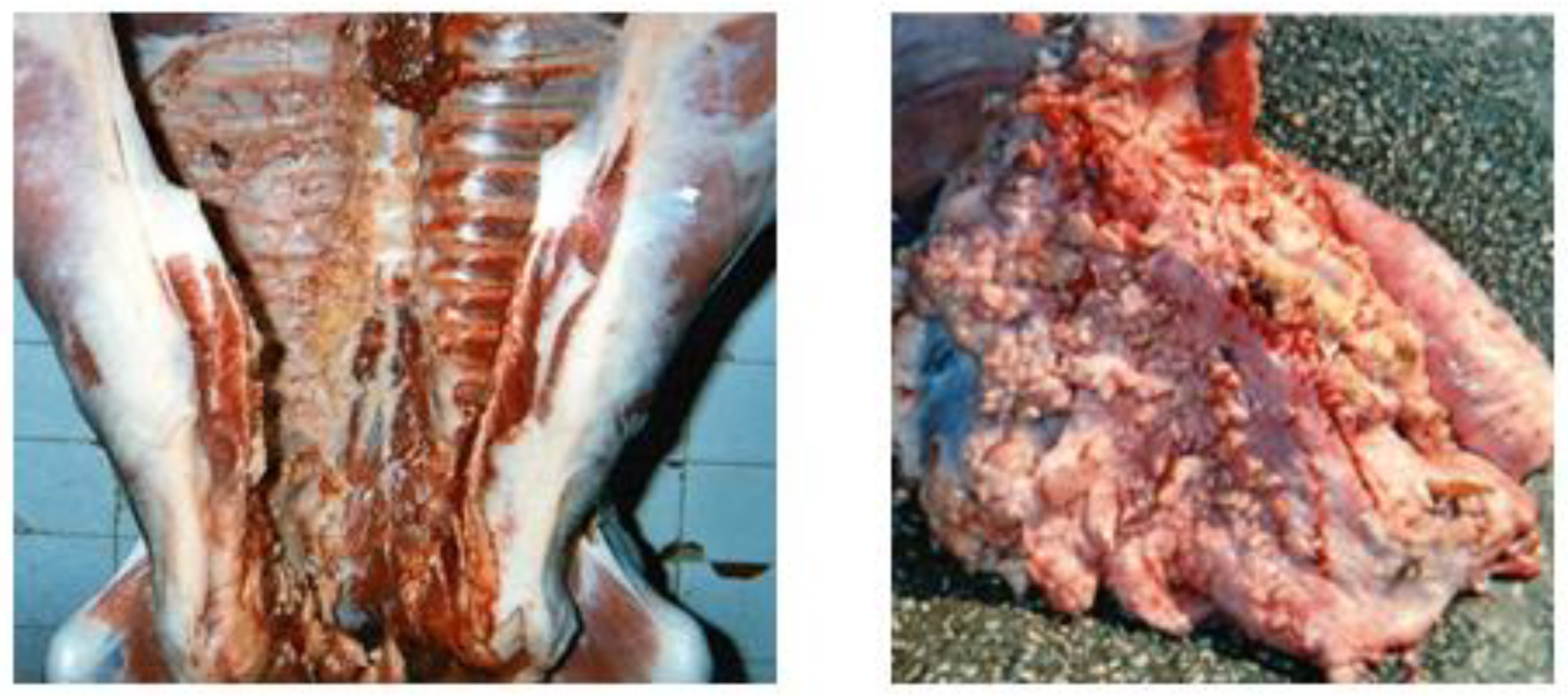
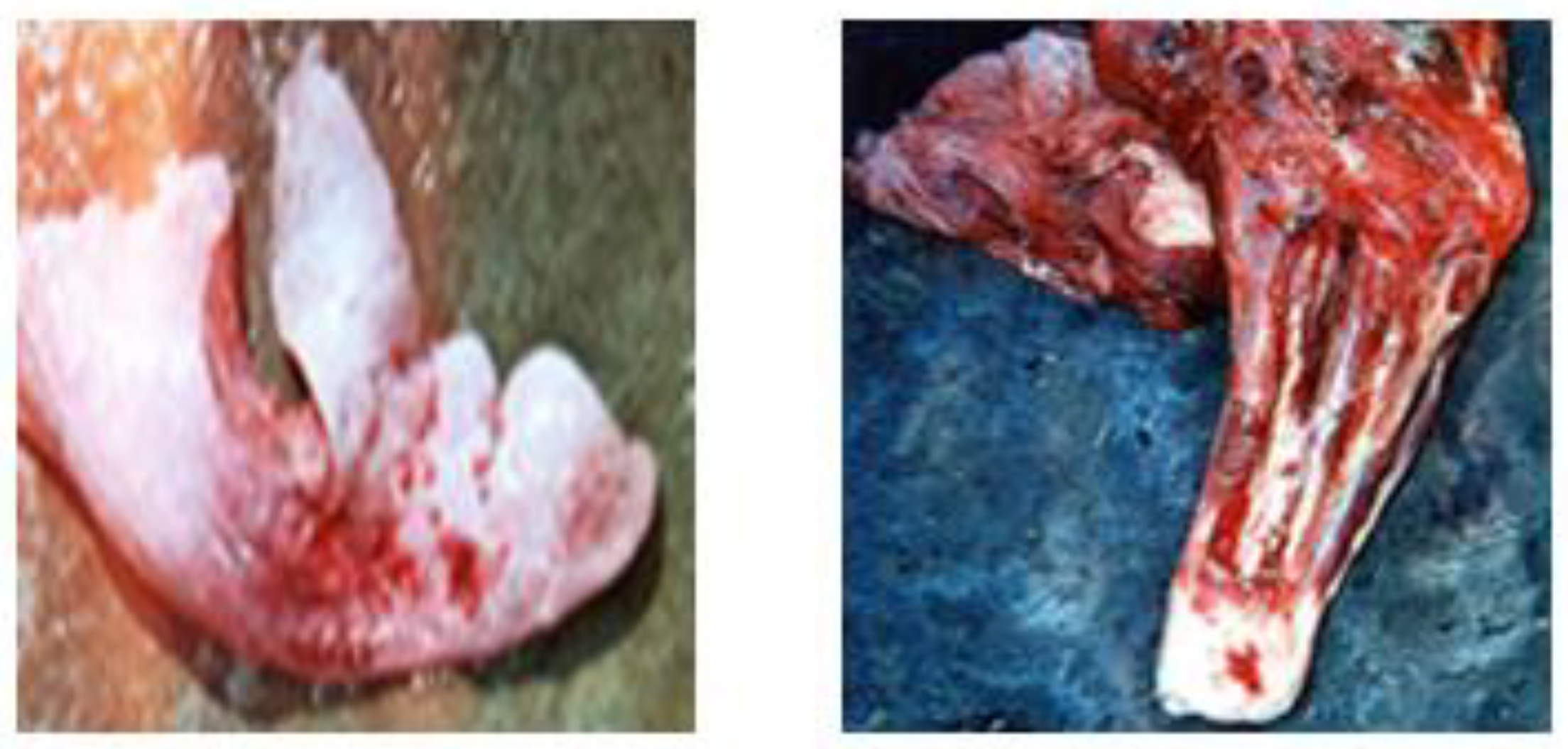


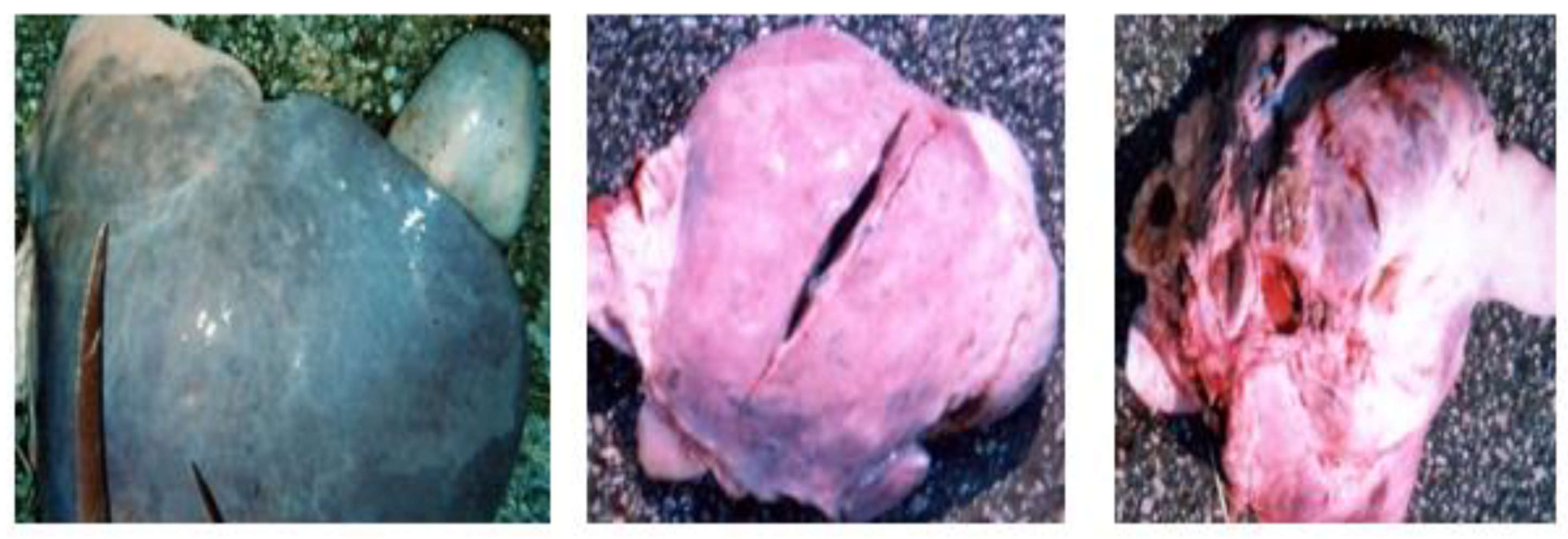



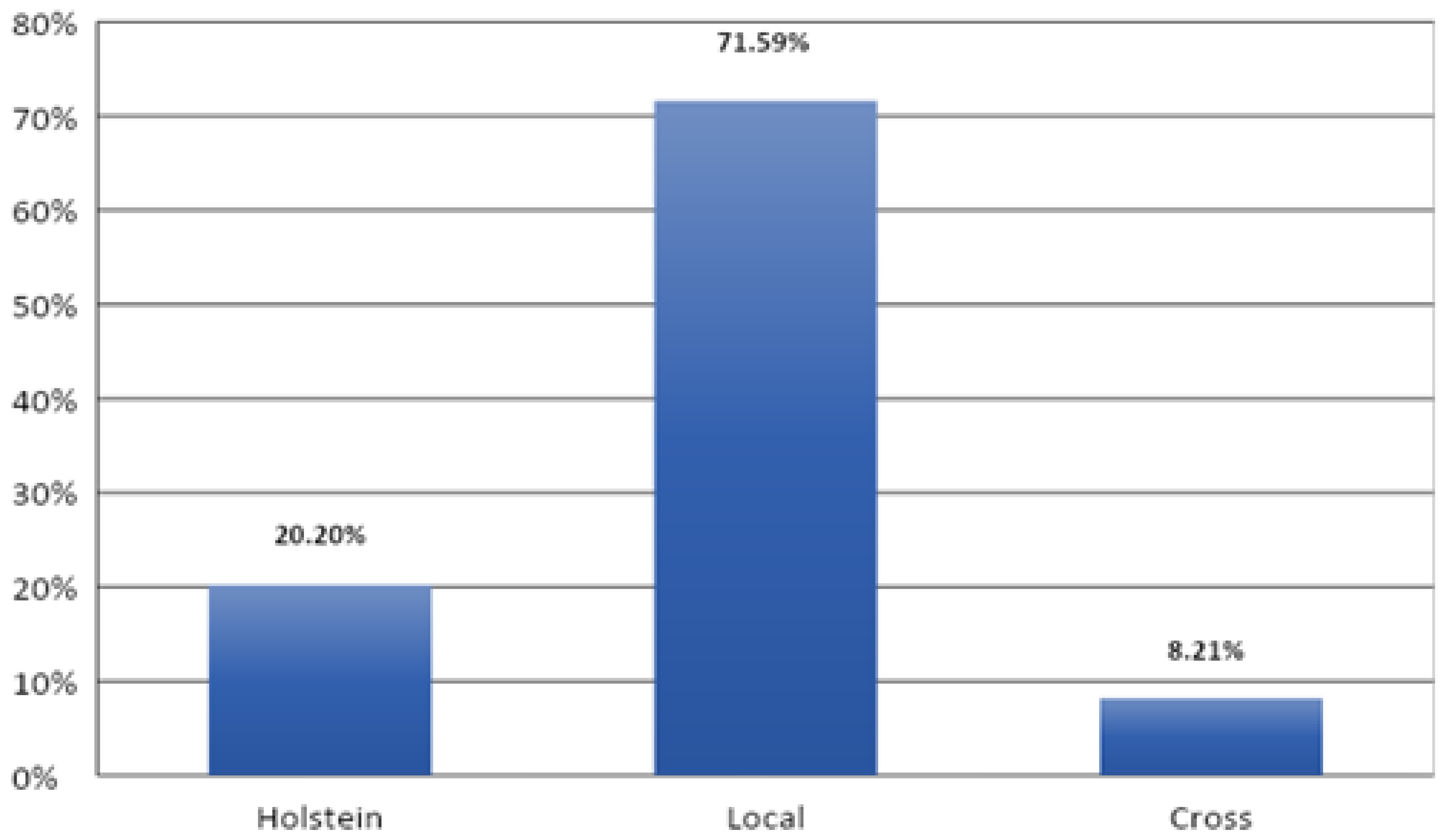
| Organs | Number of Cases | % |
|---|---|---|
| Lung | 184 | 10.48 |
| Liver | 227 | 12.93 |
| Carcass | 46 | 2.62 |
| Heart | 27 | 1.54 |
| Kidney | 7 | 0.40 |
| Digestive system | 2 | 0.11 |
| Reproductive system | 116 | 6.61 |
| Total | 609 | 34.68 |
| Mean ± SD | 87.00 ± 90.14 | 4.95 ± 5.13 |
| p value | <0.001 |
| Organ | Lesion | Number of Cases | % | p Value |
|---|---|---|---|---|
| Lung | Slaughter defect | 11 | 1.81 | p < 0.05 |
| Pneumonia | 12 | 1.97 | ||
| Abscess | 45 | 7.39 | ||
| Hydatidosis | 116 | 19.05 | ||
| Liver | Fascioliasis | 67 | 11.00 | p < 0.05 |
| Hepatitis | 28 | 4.60 | ||
| Hydatidosis | 126 | 20.69 | ||
| Telangiectasia | 6 | 0.98 | ||
| Carcass | Traumatic meat | 39 | 6.40 | p < 0.05 |
| Generalized tuberculosis | 4 | 0.66 | ||
| Jaundice | 2 | 0.33 | ||
| Others | 1 | 0.16 | ||
| Heart | Pericarditis | 27 | 4.43 | |
| Kidney | Nephritis | 7 | 1.15 | |
| Digestive | Paramphistomosis | 1 | 0.16 | p > 0.05 |
| Gastroenteritis | 1 | 0.16 | ||
| Urogenital system | Uterine infections | 53 | 8.70 | p < 0.05 |
| Ovarian cyst | 41 | 6.73 | ||
| Salpingitis | 22 | 3.61 | ||
| Total | 609 | 99.99 | ||
| Mean ± SD | 30.45 ± 36.75 | 5.00 ± 6.04 | ||
Publisher’s Note: MDPI stays neutral with regard to jurisdictional claims in published maps and institutional affiliations. |
© 2022 by the authors. Licensee MDPI, Basel, Switzerland. This article is an open access article distributed under the terms and conditions of the Creative Commons Attribution (CC BY) license (https://creativecommons.org/licenses/by/4.0/).
Share and Cite
Mimoune, N.; Hamiroune, M.; Boukhechem, S.; Mecherouk, C.; Harhoura, K.; Khelef, D.; Kaidi, R. Pathological Findings in Cattle Slaughtered in Northeastern Algeria and Associated Risk Factors. Vet. Sci. 2022, 9, 330. https://doi.org/10.3390/vetsci9070330
Mimoune N, Hamiroune M, Boukhechem S, Mecherouk C, Harhoura K, Khelef D, Kaidi R. Pathological Findings in Cattle Slaughtered in Northeastern Algeria and Associated Risk Factors. Veterinary Sciences. 2022; 9(7):330. https://doi.org/10.3390/vetsci9070330
Chicago/Turabian StyleMimoune, Nora, Mourad Hamiroune, Said Boukhechem, Choayb Mecherouk, Khaled Harhoura, Djamel Khelef, and Rachid Kaidi. 2022. "Pathological Findings in Cattle Slaughtered in Northeastern Algeria and Associated Risk Factors" Veterinary Sciences 9, no. 7: 330. https://doi.org/10.3390/vetsci9070330
APA StyleMimoune, N., Hamiroune, M., Boukhechem, S., Mecherouk, C., Harhoura, K., Khelef, D., & Kaidi, R. (2022). Pathological Findings in Cattle Slaughtered in Northeastern Algeria and Associated Risk Factors. Veterinary Sciences, 9(7), 330. https://doi.org/10.3390/vetsci9070330




